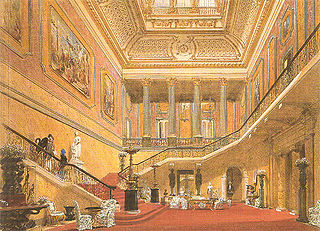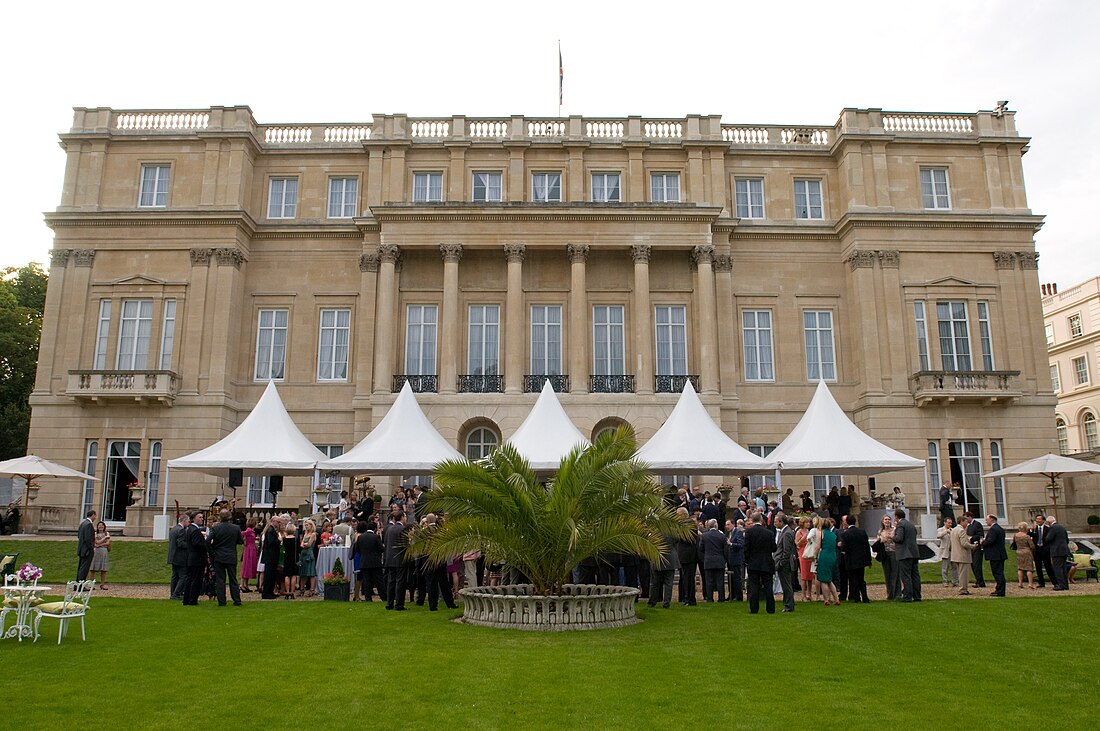Lancaster House
Mansion in St James's, London From Wikipedia, the free encyclopedia
Lancaster House (originally known as York House and then Stafford House) is a mansion on The Mall in the St James's district in the West End of London. Adjacent to The Green Park, it is next to Clarence House and St James's Palace, as much of the site was once part of the palace grounds.
| Lancaster House | |
|---|---|
 | |
 | |
| General information | |
| Architectural style | Neo-classical |
| Location | St James's London, SW1 United Kingdom |
| Coordinates | 51°30′14″N 0°8′21″W |
| Current tenants | Foreign, Commonwealth and Development Office |
| Construction started | 1825 |
| Completed | 1840 |
| Owner | HM Government |
| Technical details | |
| Floor count | Three (plus basement) |
| Design and construction | |
| Architect(s) | Benjamin Dean Wyatt (interior and exterior) Sir Charles Barry (interior) Sir Robert Smirke (interior) |
| References | |
Listed Building – Grade I | |
| Official name | Lancaster House |
| Designated | 5 February 1970 |
| Reference no. | 1236546 |


Initially planned for Prince Frederick, Duke of York and Albany, it was ultimately completed by the Duke of Sutherland, then Marquess of Stafford, as an aristocratic townhouse in the early 19th century, and known for its lavish interiors. Gifted to the government in the early 20th century, it houses the government's wine cellars and was home to the London Museum until World War II. Now used for diplomatic receptions and related functions by the Foreign Office, it is a historic Grade I listed building,[1] and its interiors are sometimes used in films or television as a stand-in for Buckingham Palace.
History
Summarize
Perspective
Construction of the house commenced in 1825 for the Duke of York and Albany, the second son of King George III, and it was initially known as York House.[2]: 155 Sir Robert Smirke was originally hired to design the house, until under the influence of the Duke's mistress the Duchess of Rutland, he was replaced by Benjamin Dean Wyatt who mainly designed the exterior.[2]: 155 The house was only a shell by the time of the death of the Duke in 1827. It is constructed from Bath stone, in a neo-classical style. The lease of the house was purchased by the 2nd Marquess of Stafford (later 1st Duke of Sutherland) and was under his direction that it was completed in 1838.[1] It was known as Stafford House for almost a century.[3]
The completed building was three floors in height, the State rooms being on the first floor or piano nobile, family living rooms on the ground floor and family bedrooms on the second floor. There was also a basement containing service rooms and wine cellar. The interior, featured an imperial staircase which was designed by Sir Charles Barry, as well Louis XIV Style rooms which were lavishly decorated.[1]
The Sutherlands’ liberal politics and love of the arts attracted many distinguished guests, including factory reformer the Earl of Shaftesbury, anti-slavery author Harriet Beecher Stowe and Italian revolutionary leader Giuseppe Garibaldi. Chopin gave a recital there in 1848 in the presence of Queen Victoria.[4]
Queen Victoria is said to have remarked to the 2nd Duchess of Sutherland on arriving at Stafford House, "I have come from my House to your Palace." With its ornate decoration and the dramatic sweep of the great staircase, the Grand Hall is a magnificent introduction to one of the finest town houses in London. In 1877 the House became the eponymous home of the Stafford House Committee for the Relief of Sick and Wounded Turkish Soldiers, formed by the 3rd Duke to aid Ottoman refugees and wounded during the Russo-Turkish War.[5][6]
The house went out of royal favour after the 3rd Duchess died, in 1888 and her husband married his mistress within months.[7] In 1912 the lease was purchased by the Lancastrian industrialist and philanthropist Sir William Lever, 1st Baronet (later 1st Viscount Leverhulme) who renamed it in honour of his native county of Lancashire and presented it to the nation in the following year.[2]: 158–161
Since 1922 the building has housed the Government Wine Cellar,[8][9] and, from 1924 until shortly after the Second World War, the house was the home of the London Museum.[10]
The Allied Governments' European Advisory Commission on the political and social future of Europe after the Second World War met here throughout 1944 and into 1945. In January 1947 a special envoy meeting on affairs concerning occupied Austria was hosted here. The year 1956, the house saw the signing of the agreement of independence for Malaya. In 1961, South Africa affirmed its intention to become a republic, inside the Commonwealth. In 1979 it was the scene of the Lancaster House Agreement, which led to the independence of Rhodesia, now Zimbabwe, from the United Kingdom.[2]: 161
The house was the venue for the 10th G7 summit in 1984 and the 17th G7 summit in 1991.[11] A new 35-foot-long table was built for the Long Gallery, where the main negotiating sessions were planned in 1991.[12]
Prime Minister Theresa May gave a speech at Lancaster House in January 2017 outlining Britain's intended future relationship with the European Union following the 2016 United Kingdom European Union membership referendum which resulted in a vote to leave. The speech is commonly referred to in the media, and in political discourse, as the "Lancaster House speech".[13]
In popular culture
Summarize
Perspective
Winston Churchill commented that towards the end of the 19th century, "glittering parties at Lansdowne House, Devonshire House or Stafford House (Lancaster House) comprised all the elements which made a gay and splendid social circle in close relation to the business of Parliament, the hierarchies of the Army and Navy, and the policy of the State."[14]
Lancaster House has been extensively used as a filming location. It has stood in for Buckingham Palace at least six times in film and television: for the comedy film King Ralph (1991),[15] the mystery adventure film National Treasure: Book of Secrets (2007),[16] the historical drama film The Young Victoria (2009),[17] the historical drama film The King's Speech (2010),[18] and the 2013 Christmas special for Downton Abbey, when Rose is presented to the King and Queen during the London Season.[19] Lancaster House reprised its role as Buckingham Palace for the Netflix series The Crown.[20] The interior was used to represent the Winter Palace in St. Petersburg for the 1981 film Reds. It also appears as the house of Lady Bracknell in the comedy of manners film The Importance of Being Earnest (2002), and as the site of a masquerade ball in the Merchant-Ivory film The Golden Bowl (2000).[21][22]
See also
References
Bibliography
External links
Wikiwand - on
Seamless Wikipedia browsing. On steroids.
